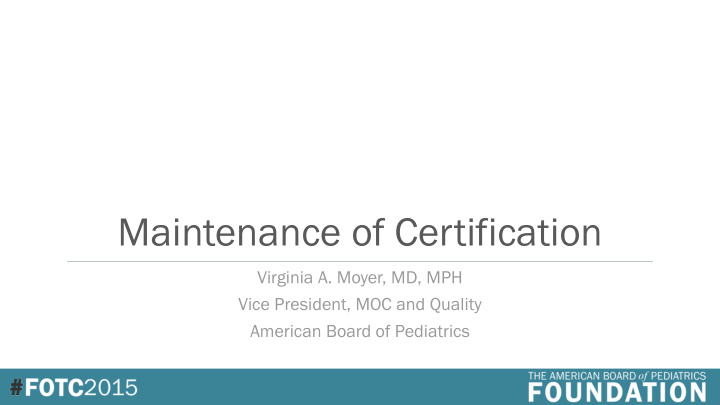



Maintenance of Certification Virginia A. Moyer, MD, MPH Vice President, MOC and Quality American Board of Pediatrics
Four-part Model Ongoing process of lifelong learning and self-assessment to The four-part MOC continuously improve process assures the knowledge and public that pediatricians clinical performance involved in MOC are continually demonstrating clinical competence.
Part 1: Professional Standing & Licensure To maintain certification, a physician must be licensed and in good standing.
Part 2: Self Assessment (SA) and Lifelong Learning • Per ABMS, Part 2 activities “should emphasize learning based on self- assessment” • ABP approves Part 2 activities only if they include a self-assessment component consisting of at least 25 MCQs (must be web-based); live CME that includes a self assessment is encouraged • 145 Part 2 activities currently available • Almost all earn CME credit (AAP is provider)
Self Assessment Activities • ABP Subspecialty self-assessments (45) • Created annually by sub-boards • Based on current literature • Not tied to exam blueprint • Each one is “live” for 3 years • Other ABP self-assessment activities • SA’s Created by subject matter experts (6 topics) • Usually tied to new Performance Improvement Modules (PIMS) in Part 4 • Question of the Week, Decision Skills, General Pediatrics Knowledge Skills Assessment
External Self Assessments Self Assessments from other organizations • AAP PREP, general and subspecialty • These are tied to the exam blueprints • Other professional societies • Academic institutions • Commercial vendors • Online Board review courses • These are tied to exam blueprints
Part 4: Improvement in Medical Practice • Per ABMS: “ongoing practice assessment and improvement”…“including adequate knowledge of quality improvement science and methods” • ABP uses an improvement model, in which demonstration of practice assessment and application of interventions intended to improve outcomes is required, but demonstrated improvement is not required
Part 4 Activities • Workplace-based Quality Improvement (QI) Projects: • QI Collaboratives and Networks • Institutionally based QI programs and projects • Diplomate-initiated QI projects • All require attestation of meaningful involvement by the diplomate • Online QI modules • ABP Project Improvement Modules (PIMs) • Online Modules from other organizations
ABP PIM topics • ADHD (initial diagnosis) • Obesity Assessment and Management • ADHD (follow up) • Preschool Vision Screening • Adolescent Depression Screening • Preterm Admission Temperature • Asthma • Safe Prescription and Medication Order Writing • Breast Milk Use • Motivational Interviewing, Medication • Chlamydia Screening Adherence • Critical Congenital Heart Disease • NICU/PICU Blood Stream Infections Newborn Screening • New Simulated Data PIM • Developmental Screening • Hand Hygiene • Health Literacy • Influenza Immunization
QI Activity Requirements • Identify a gap in quality or practice • Requires measurement • Identify a goal (Aim statement) • Plan and execute interventions intended to result in improvement • Measure results • Multiple measurements over time are required • Reflect on results and determine next steps
Questions for Discussion • What is the role of Part 3? • Should it remain about the measurement of competency? • Should it be about learning? • What, if any, could be an appropriate balance? • Should it remain a summative evaluation? • In what ways can Part 2 and Part 4 be used to improve Part 3? • How could Part 2 and Part 4 be a part of an integrated summative evaluation?
Recommend
More recommend